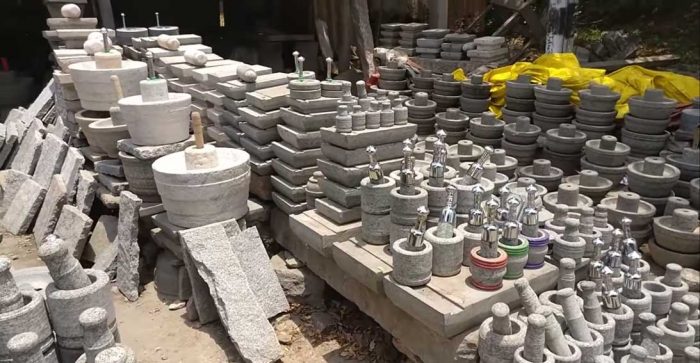Engaged for more than 50 years in the manufacturing of Mortar, pestle, stone grinders. pounders etc we showcase here a few artisans based at Coimbatore, Tamilnadu, India.
These stone grinders are an healthier alternative to the electrical mixers and grinders. The grinding stones come with steel or wooden handles.
Their product range includes:
- 4 inch / 5 inch Ginger-garlic pounder
- Ginger pounder for making tea
- Herbs / herbal leaves pounder/grinding stone made of granite or marble.
- Face pack mortar and pestle
- Incense stick stand made of marble
- Tobacco-betel nut pounder
- 10 inch grinding stone
- Masala grinding stone
- Grinder stones
- Sandal turmeric grinder for bathing.
- 8 inch grinding stones for processing millets, urad dal. Green gram, cow pea/ black eye bean, Split Yellow Gram/Pigeon Peas/Toor dal
- Stone roti/chapati maker
- Garden pavement stones
- Wooden handles, metal handles
- Stone Uruli
MANUFACTURERS:
Paraman Stone Works Manufacturers of Mortar Pestle Stone Grinders
Sivananda Colony to Mettupalayam Road,
Near Railway Bridge,
Puthupalam,
Coimbatore..
Tamilnadu, India
Whatsapp No: +91 9894303694
Angaleswari,
Sivanandha Colony,
Pudhupalam (Under Railway Bridge),
Coimbatore
Mobile: +91 9042597042 / +91 9894436356
Artisans @ Pettikadai Village,
Uthukuli,
Tiruppur District
Tamilnadu, India
You may also be interested in these artisans:
Exquisite Handcrafted Stone Sculptures
Mortar and pestle is a set of 2 simple tools used since the Stone Age up to the present day to prepare ingredients or substances by crushing and grinding them into a fine paste or powder in the kitchen, laboratory, and pharmacy. The mortar is a bowl, typically made of hard wood, metal, ceramic, or hard stone, such as granite. The pestle is a blunt club-shaped object. The substance to be ground, which may be wet or dry, is placed in the mortar, where the pestle is pounding, pressing and rotating onto the substance, until the desired texture is achieved.
Mortars and pestles have been used in cooking since prehistory; they are also frequently associated with the profession of pharmacy due to their historical use in preparing medicines. Mortars and pestles can also be used in chemistry for pulverizing small amounts of chemicals; in arts and cosmetics for pulverizing pigments, binders, and other substances; in ceramics for making grog; in masonry and in other types of construction requiring pulverization of materials. In cooking, mortars and pestle are especially used to crush spices and to make pesto, and certain cocktails, such as the mojito, require the gentle crushing of sugar, ice and mint leaves in the glass with a pestle.
The use and invention of mortars and pestles seems related to the invention of quern-stones, using a similar principle of naturally indented, durable, hard stone bases and mallets of stone or wood to process food, clay, minerals or plant materials by crushing, pulverizing and grinding. The advantage of a mortar over a quern-stone is that the mortar is a deeper bowl containing the ground material without wasting and spilling it over the edges, like the material would be with flat grinding stones. Another advantage of mortars is that they can be made large enough for a person to stand upright next to them and use the combined strength of their entire upper body and gravity for better stamping. These large mortars also allow for several people with several pestles stamping the material in the same mortar faster and more efficient. Large mortars which a person can stand next to in an upright position are also physically easier to use and are more ergonomical by ensuring a better posture of the whole body than small querns, where a person has to crouch and use the uncomfortable, repetitive motion of hand grinding by sliding.
Mortars and pestles predate the invention of automatic blenders and grinders. Mortars and pestles can be described as having the function of small, mobile, hand operated mills, that don’t require electricity or fuel to work.
The large wooden mortars and wooden pestles would predate and lead into the invention of butterchurns, since domestication of livestock and use of dairy came much later than the invention of mortar and pestle in the Neolithic. For churning, a wooden container would have the butter churned in it from cream or milk, with a long wooden stick, just like with wooden mortars and pestles.
https://en.wikipedia.org/wiki/Mortar_and_pestle
